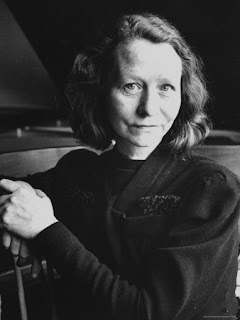Fiore de Henriquez - a new film
.jpg) I learned yesterday on Facebook that a young English film-maker living in America is in the final stages of a documentary about the Italian sculptor Fiore de Henriquez, who created Peralta. Richard Whymark came to Peralta last year to look at the hamlet and film some background. We also got to talk to him about Fiore and tried to find out what his approach to her life and work was going to be. This is obviously of some interest, and the cause of some apprehension, among those who knew her. Richard wasn’t revealing anything, so we still don’t know what his ‘angle’ is going to be.
I learned yesterday on Facebook that a young English film-maker living in America is in the final stages of a documentary about the Italian sculptor Fiore de Henriquez, who created Peralta. Richard Whymark came to Peralta last year to look at the hamlet and film some background. We also got to talk to him about Fiore and tried to find out what his approach to her life and work was going to be. This is obviously of some interest, and the cause of some apprehension, among those who knew her. Richard wasn’t revealing anything, so we still don’t know what his ‘angle’ is going to be.Fiore was one of the most remarkable people I have ever met. She was an imposing personality - nearly six feet tall, with strong arms, a shock of white hair and the most extraordinary eyes. They looked at you with such penetration, it was hard not to believe that she couldn’t see inside the very landscape of your soul. But they were also full of sadness and supplication.
Fiore was born in 1920 - one of the two in every ten thousand babies born every year with ‘gender indeterminacy’. She was, she told everyone quite frankly, a haemaphrodite - the union of Hermes and Aphrodite. Her birth sign was Gemini, the heavenly Twins. ‘I can see both sides,’ she used to say, ‘because I am both sides.’ It was both her tragedy and her gift. Many of her sculptures and paintings depict double images, reflections, siamese twins.
 She was incredibly beautiful when she was young, as this photograph by Felix Fonteyne reveals. But her life was a restless search for personal happiness and artistic fulfilment. She had many lovers - some of them prominent figures in American and British society. She lived and worked with several big names in art, sculpted Augustus John, John F. Kennedy, the Queen Mother and many other celebrities. It was a life rich in anecdote and scandal. Fiore cared little for what people thought - she lived at full speed, right to the end.
She was incredibly beautiful when she was young, as this photograph by Felix Fonteyne reveals. But her life was a restless search for personal happiness and artistic fulfilment. She had many lovers - some of them prominent figures in American and British society. She lived and worked with several big names in art, sculpted Augustus John, John F. Kennedy, the Queen Mother and many other celebrities. It was a life rich in anecdote and scandal. Fiore cared little for what people thought - she lived at full speed, right to the end.Friends worry that the documentary might focus too much on her gender identity problem, and too little on her artistic achievement. When I first came to Peralta, Fiore was in the early stages of Alzheimer’s disease, and my friend Jan Marsh was writing her biography - ‘Art and Androgyny’. Getting the balance right was Jan’s central problem, and she probably erred too much on the side of caution. It is right to avoid prurient curiousity, but Fiore’s unique sexuality was so much a part of herself and her art that it has to be fully addressed. It will be interesting to see how Richard Whymark has tackled it.
One of her greatest creations was the hamlet of Peralta itself, which was a ruin on the hillside until she found it in the 1960s, traced all the original owners of the houses and little farms, then rebuilt and restored it. She wanted Peralta to be a place where writers and artists could meet, live and work. Not just for tourists. Unfortunately she didn't realise that most of them can't afford the kind of creative space that Peralta offers. Richard Whymark made a short film of Peralta when he was here, which I will include below.


Comments
Post a Comment